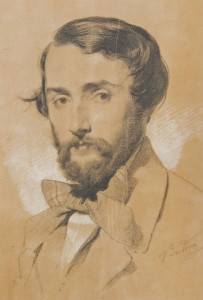When artists paint artists – palazzo Belgioioso
by Massimo Pulini
 Palazzo Belgioioso in Milan, in the Risorgimento years, used to host a group of artists that, according to their own statute, were going to add to the walls the portrait of each new group participant . Artists painting other artists’ portraits, artists as noble mirrors to sitting friends. Look, thinking expression, hair cut, moustache and beard care, stiff collar and eyes vivacity make these faces a distillate of each character and on the whole a sharp and exact repertory of the moral and political sense of some Italian generations.
Palazzo Belgioioso in Milan, in the Risorgimento years, used to host a group of artists that, according to their own statute, were going to add to the walls the portrait of each new group participant . Artists painting other artists’ portraits, artists as noble mirrors to sitting friends. Look, thinking expression, hair cut, moustache and beard care, stiff collar and eyes vivacity make these faces a distillate of each character and on the whole a sharp and exact repertory of the moral and political sense of some Italian generations.
This set of bright and quiet faces, portrayed in a weekly dimension of an evening spent discussing, a glass of water aside and a sigar waiting on an ashtray, means at my eyes much more than the packed paintings of historical theme, explaining events of national Risorgimento or the social rhetoric of the times.
With an astonishing expressive synthesis, catched in the sobriety of a black pencil as the only investigation tool, of a white chalk for the maximum light points, with just a sheet of pastel coloured paper and a careful and cautious glance, the elegant discipline of these Lombard portraits comes about. An elegance that from the intellectual aristocracy comes towards the characteristic features of the incoming middle-class world, as if with no solution of continuity. All this takes in its whole something like a film.
A sort of documentary is going to take shape, in a sequence of faces and thoughts, attitudes and nature of a series of painters and sculptors that marked taste and customs of a cultural and political capital town between the end of the XIX century and the beginning of the XX century.
